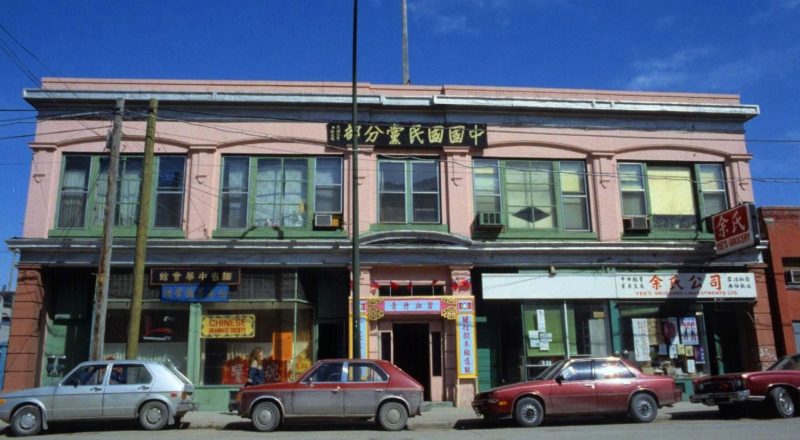
/ Blog
February 27, 2024
A Hidden Dragon: The Johnstone Block
A new moon rose in the night sky above Winnipeg on February 10th, 2024, as the Lunar New Year arrived. In some places it was the start of 15 days of festivities, ending in the Lantern Festival on February 24th. The exact date of the Lunar New Year changes every year as it is determined using a lunisolar calendar, which places the event on the new moon closest to the northern hemisphere’s arrival of spring. The 2024 celebration also ushered in the year of the wood dragon, according to the Chinese zodiac. The dragon is thought to be a very powerful and noble creature, bringing exciting changes and good luck, while wood is a nourishing element. For many Asian communities around the world, the Lunar New Year is a very important holiday. Families gather from near and far to exchange gifts, honour gods and ancestors, eat important foods, enjoy spectacular performances and more. Although traditions have changed over time and from family to family, it is still a special season, when the past is put to rest and a new chapter is eagerly begun.
The Chinese have been celebrating the Lunar New Year for thousands of years, sometimes called the Spring Festival in China or Chinese New Year in other parts of the world. In Winnipeg, these traditions could have first arrived in the city in November of 1877, when the first Chinese people arrived by stagecoach from the United States. It was a modest beginning, just three individuals. Winnipeg’s Chinese community remained small, even after the completion of the transcontinental railway in 1886, which brought more immigrants to the west. During this early period many of the Chinese people in the city were in the laundry business, of which the establishments were intentionally located apart from one another so as to not be in direct competition. This was a factor in the community being quite dispersed across Winnipeg and no central Chinatown being established.
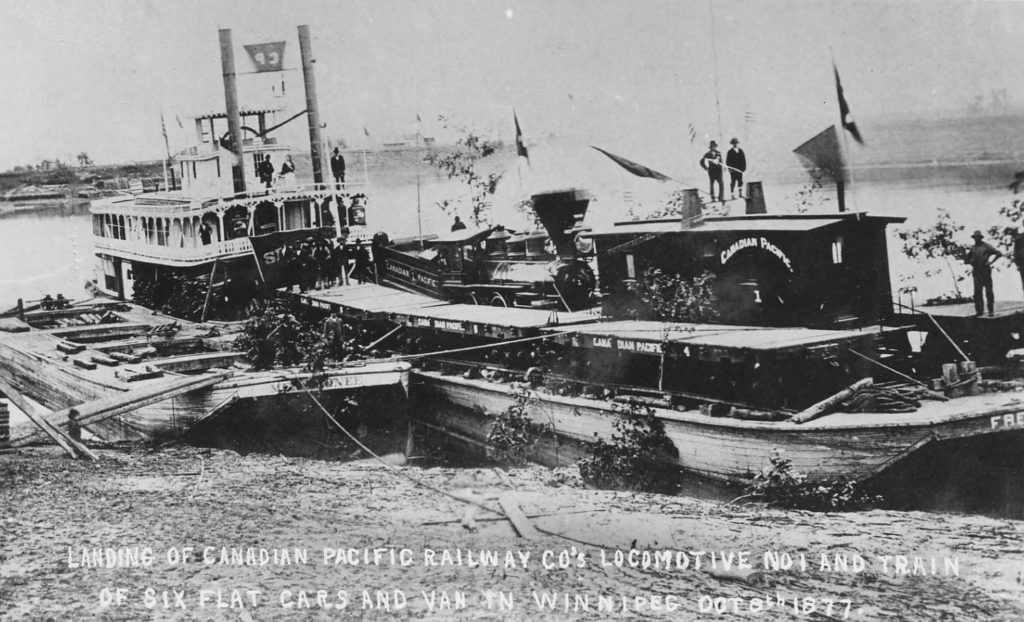
The Countess of Dufferin arrived in Winnipeg on October 8th 1877, only a month before the first Chinese people. It was the first steam locomotive to operate in Western Canada and imperative to the development of the railway.
Source: The Rob McInnes Postcard Collection (Winnipeg Public Library)
The Chinese population in Winnipeg grew dramatically in the first decade of the 20th century, with over 500 individuals living in the city by 1911. In 1909, Winnipeg’s Chinatown finally put down roots with a few stores located at the intersection of King Street and Alexander Avenue. Within a year, an entire block was filled with a variety of Chinese businesses and residences.
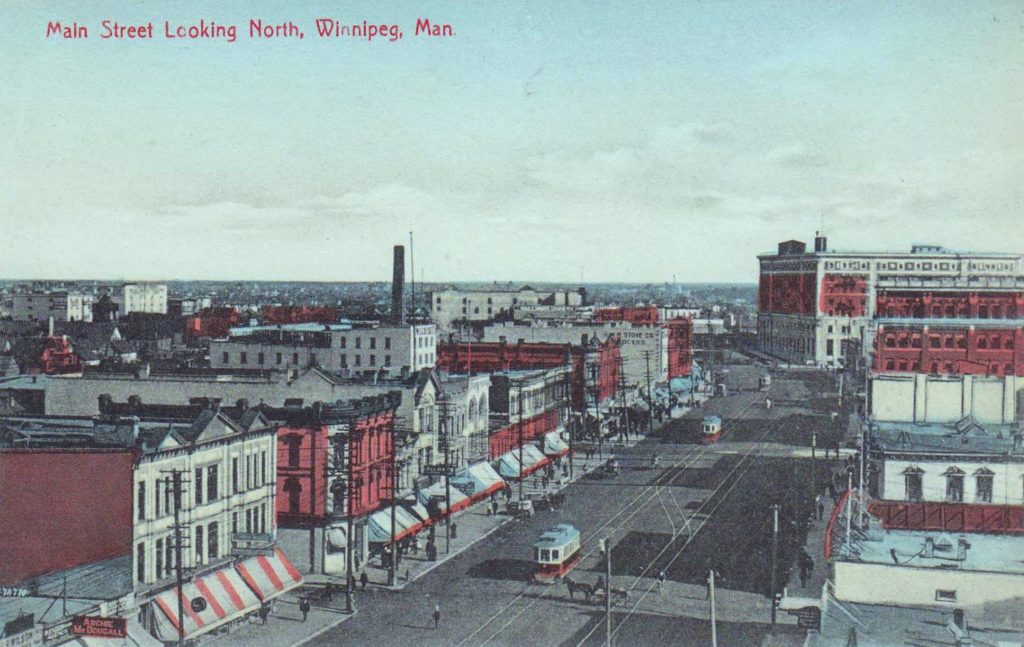
Main Street looking north from about Pacific Avenue, some time between 1906 and 1910. Winnipeg’s Chinatown was established one block west of Main Street, just past the left edge of the image.
Source: The Rob McInnes Postcard Collection (Winnipeg Public Library)
It was at the end of this period of development, in 1910, that the Johnstone Block was built at 209 Pacific Avenue. It was located only a block and a half over from the heart of Chinatown. Later known as the Kuo Min Tang Building, the solid brick Two-Part Commercial Style building was constructed by local real estate agents James and Robert Johnstone. The first floor had retail space while the second floor was used for office space or residential units. Classical features, including a metal entablature and a curved pediment over the front entrance, along with decorative ornamentation, such as the two metal cornices, ornamental tin ceilings, glass blocks and tile floors, made the Johnstone Block a far more fancy version of this style of architecture when compared to its contemporaries in the city. Costing about $27,000 to build, it was designed by the prolific prairie architect Frank Robert Evans.
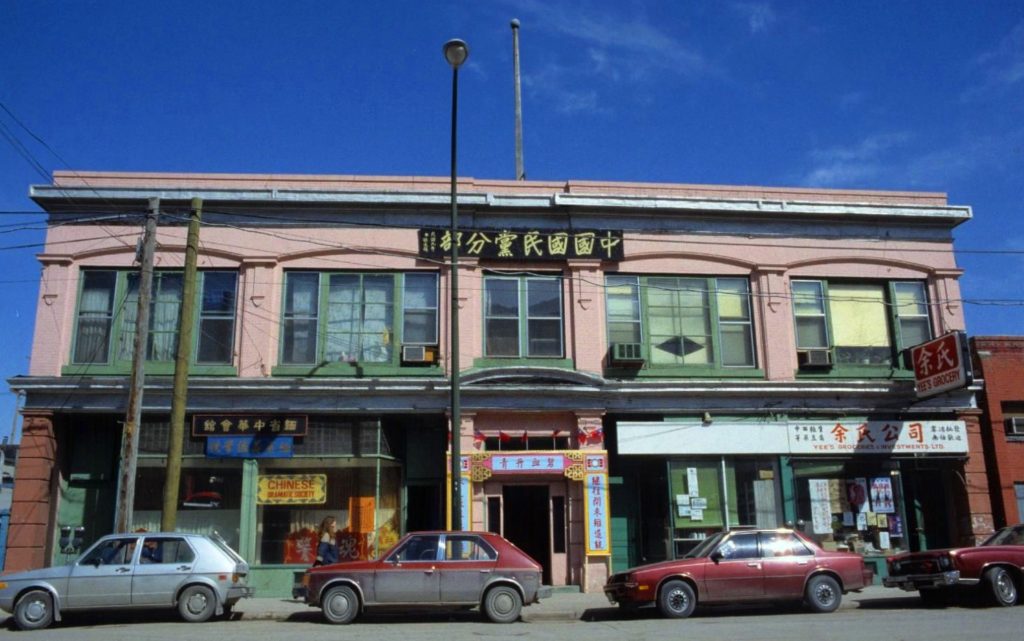
The Johnstone Block at 209 Pacific Avenue in 1986.
Source: Winnipeg Building Index (University of Manitoba Libraries)
Chinatown continued to grow along with the Chinese population in Winnipeg, which reached over 900 by 1920. In the 1930s, the population began to decline with families leaving Chinatown and other non-Chinese businesses moving in. By this time, two fur companies were operating in the Johnstone Block, a remnant of the fur trade that began in Western Canada in the 17th century. While the fur companies remained stable tenants in the Johnstone Block in the 1940s and 1950s, a growing number of the other businesses and organisations in the building were Chinese, eventually including the Chinese Dramatic Society, Chinese Benevolent Association, Manitoba Chinese Cultural Association Incorporated and the Prairie Chinese News of Canada. James and Robert Johnstone continued to own the Johnstone Block as a rental property until the late 1940s, when it was sold. The building had various owners after the Johnstone pair, often occupants of the block.
The Winnipeg branch of Kuo Min Tang moved into the building some time in the 1930s, becoming a cornerstone tenant and owning the building for some time. The Kuomintang, also known as the Chinese Nationalist League, was a Chinese political movement that worked to overthrow the Chinese monarchy. It became the ruling political party in China from 1928 to 1949. The Kuomintang was popular among young Chinese people who fled Imperial China, setting up branches in the west to raised funds for its cause while functioning as cultural hubs and community centres. The Kuomintang was later exiled from China, becoming a political party in Taiwan. At the Johnstone Block, the flag of Taiwan has long been flown high above the main entrance. It was the flag of the Republic of China when the Kuomintang was in power there, with the colours red, white and blue representing nationalism, democracy and socialism. Is a reminder of the building’s connection to major events in history that unfolded on the other side of the world.

The flag of Taiwan. The white sun on the blue field was the Kuomintang party flag, while the red background represented the Han people, the largest ethnic group in the China.
Source: Canva
The 1960s was a challenging time for Winnipeg’s downtown, including Chinatown. Following the Second World War, much of the population had migrated to the suburbs, leaving the older inner city to decay. It was a common problem in North America, and the solution proposed seemed simple: demolish the inner city and start again. In Winnipeg, it started with the demolition of two blocks on the west side of Main Street, containing the Gingerbread City Hall, Central Fire Hall and the 1889 market building behind City Hall. They were replaced with the modernist City Hall we see today and several auxiliary buildings, some which have now been demolished.

Winnipeg’s market building, seen here converted into civic offices, was demolish in 1964. Behind it is Winnipeg’s ornate Gingerbread City Hall, complete with clock tower, demolished in 1962.
Source: Martin Berman Postcard Collection (Winnipeg Public Library)
The “Cultural Centre Renewal Scheme” was launched in 1965, proposing three areas of redevelopment in Winnipeg: Lord Selkirk Park, the East Exchange District and part of the West Exchange District. The Lord Selkirk Park area was bulldozed and new housing was built. Limited funding resulted in only two blocks on Main Street across from City Hall in the East Exchange District being razed, replaced with the Centennial Concert Hall and the Manitoba Museum. And in the West Exchange District where the plan called for levelling Chinatown and the Johnstone Block to replace them with a shopping district (although with an “ethnic flavour”), no progress was made.

The Centennial Concert Hall (1968) in the foreground and the Manitoba Museum (1968) in the background were both built as part of the Cultural Centre Renewal Scheme, replacing historic buildings. Seen here on September 7, 2023.
Source: Heritage Winnipeg
The fate of the Johnstone Block would be in question again at the end of the decade, when the city proposed a plan to extend the Disraeli Freeway through Chinatown, which would again see much of the neighbourhood demolished. For a freeway that had taken over four decades, several referendums and $5.5 million before it finally officially opened in 1960, further expansion was not supported in Chinatown. A delegation from Winnipeg’s Chinese community was sent to city council to put a stop to the plan. Their efforts were successful and instead, the city spent $633,000 in 1971 to pave the Disraeli Freeway’s driving surface which had originally been a metal grid. Out of these efforts also sprang the Winnipeg Chinese Development Corporation, a group of property owners and businessmen from Chinatown, working on the renewal of Chinatown with new commercial and residential developments. But their “Chinatown Redevelopment Plan” never came to fruition due to pushback from the community.
Over its lifetime, the facade of the Johnstone Block has seen some substantial modifications, most notably being paint. Its current bright blue colour scheme is by no means original, but certainly helps the little building stand out as a landmark. Some of the windows and entrances have been boarded up, yet its distinctive architectural features, especially on the second floor of the facade, remain unchanged. Inside, little is known about the condition of the building but some of the ornate pressed tin ceiling is still visible in places. The neighbourhood around it has also changed, starting with the Core Area Initiative announced in 1980, which encouraged investment in Chinatown. The Winnipeg Chinatown Development Corporation was incorporated in 1981 to lead the redevelopment of the area. New housing, street beautification, the construction of the Dynasty Building, installation of the Chinese arch across King Street and more all took place in a changing Chinatown, while the Johnstone Block remained consistent.
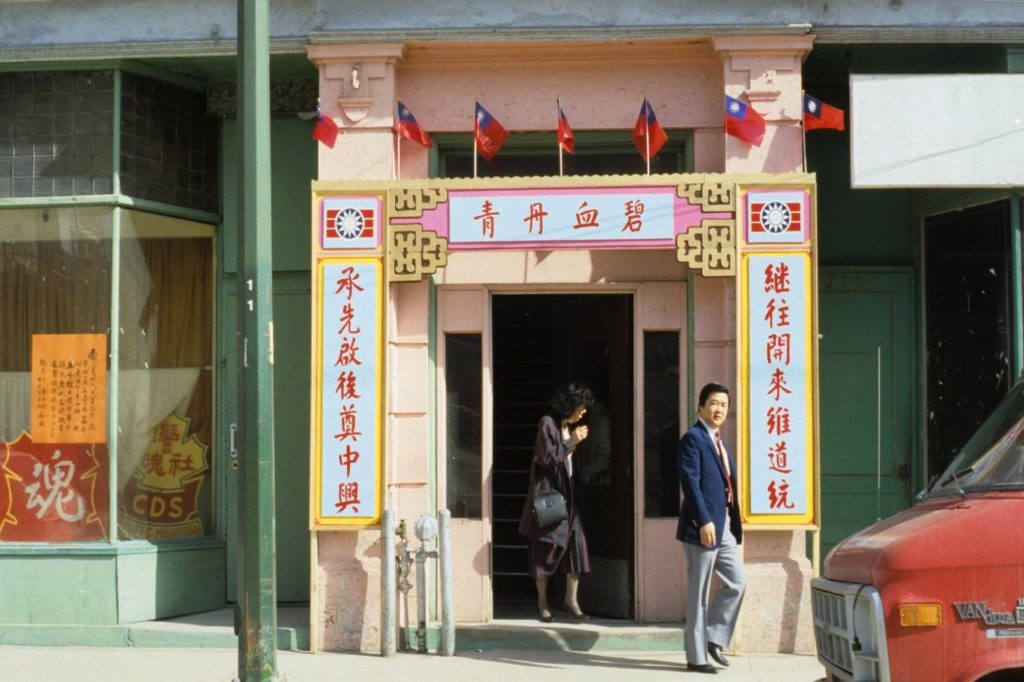
The front entrance of the Johnstone Block at 209 Pacific Avenue in 1986.
Source: Winnipeg Building Index (University of Manitoba Libraries)
In the 21st century, Winnipeg’s Chinatown continues to adapt to serve its community’s needs, integrating new buildings with the old. It is filled with shops, restaurants, cultural spaces, housing and more, while hosting exciting events like Folklorama and the Winnipeg Chinatown Night Market. Around 2008 CentreVenture had made an offer to purchase the Johnstone Block so it could be demolished and replaced with a new building. CenterVenture is an arms-length agency of the City of Winnipeg focused on development in the downtown area. Fortunately, the owners refused CentreVenture’s offer and saved the building from the wrecking ball once again. Today the Johnstone Block continues to be home to various Chinese organisations, artists and shops, with a Guy Maddin film said to have been shot in the basement. A 2018 report by CentreVenture, A Development Strategy for Northwest Exchange District and Chinatown, identified three zones in the neighbourhood for revitalization and calls for mixed use buildings – just like the Johnstone Block. Hopefully, with the support of the community, some of these ideas will someday be realised while respecting the area’s heritage.
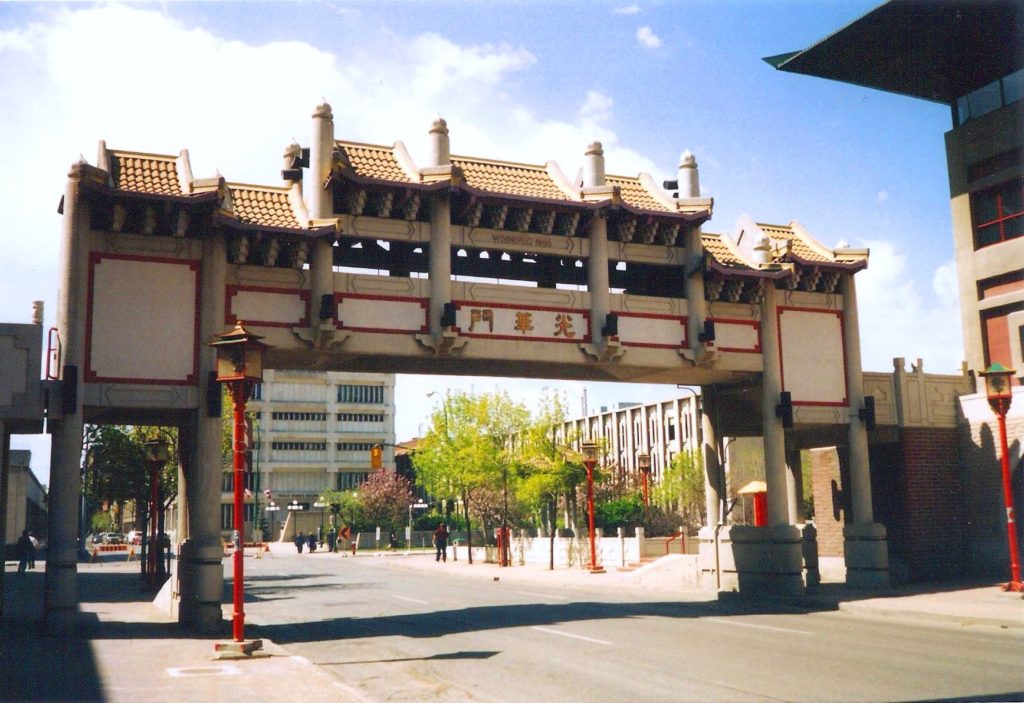
The Chinatown Gate over King Street links the Dynasty Building and the Mandarin Building. Seen here in 2003.
Source: Joe Passe (CC BY-SA 2.0, via Wikimedia Commons)
With just over 20 structures left in the neighbourhood with a connection to Chinatown, we cannot underestimate the importance of conserving buildings like the Johnstone Block. Behind their weathered old facades they are resilient hidden gems that help give their communities an identity and are a tangible connection to history. Additionally, heritage buildings usually have lower rental rates and a wide variety of spaces available, making them a more affordable option for entrepreneurs, creatives, non profit organisations and housing. They are powerful incubators at the heart of a city, adapting over the decades to better nurture their ever changing community. The Johnstone Block is fortunate to be protected from demolition by a municipal heritage designation since 2019, allowing it to continue making important contributions as a landmark in Chinatown. As the year of the wood dragon unfolds, may it bring great luck and success to the Johnstone Block and all of Winnipeg’s heritage buildings, allowing them to support vibrant, sustainable and diverse communities that connect our past with an exciting future!
THANK YOU TO THE SPONSOR OF THIS BLOG POST:

Written by Heritage Winnipeg.
SOURCES:
Building weaker communities | The Rise and Sprawl - January 14, 2009
The Death and Life of Great American Cities | Jane Jacobs - Random House - 1961
A Development Strategy for Northwest Exchange District and Chinatown | CentreVenture - October 2018
The Disrespected Disraeli Bridge | Christian Cassidy - West End Dumplings - September 24, 2008
Evans, Frank Robert | Biographical Dictionary of Architects in Canada 1800 - 1950
flag of Taiwan | Whitney Smith - Encyclopedia Britannica
Lunar New Year in Canada | Laura Neilson Bonikowsky - The Canadian Encyclopedia - January 23, 2023
The Lunar New Year: Rituals and Legends | Asia for Educators - Columbia University - 2024
Nationalist Party: Chinese political party | Encyclopedia Britannica
Old Market Square | Christian Cassidy - Winnipeg Places - June 19, 2010
Our Corporation | CentreVenture
Visionary plan pales in hindsight | Declan Schroeder - Winnipeg Free Press - February 21, 2021
Winnipeg's history | City of Winnipeg





